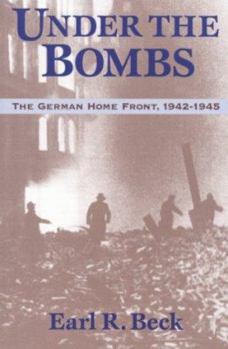Under the Bombs: The German Home Front, 1942-1945
Select Format
Select Condition 
Book Overview
Under the Bombs tells the story of the civilian population of German cities devastated by Allied bombing in World War II. These people went to work, tried to keep a home (though in many cases it was just a pile of rubble where a house once stood), and attempted to live life as normally as possible amid the chaos of war. Earl Beck also looks at the food and fuel rationing the German people endured and the problems of trying to make a public complaint while living in a totalitarian state.
Format:Paperback
Language:English
ISBN:0813109779
ISBN13:9780813109770
Release Date:August 1999
Publisher:University Press of Kentucky
Length:280 Pages
Weight:1.00 lbs.
Dimensions:0.7" x 6.0" x 9.0"
Grade Range:Postsecondary and higher
Customer Reviews
4 ratings
The side of war you don't consider.
Published by Thriftbooks.com User , 19 years ago
My parents lived through the war, my dad on the Eastern Front, and then a prisoner, and my Mom was a school girl in a large German city.My mother-in-law was a child in Coventry during the bombing. It is hard to imagine the hell people went through. As these survivors die off with old age, the life they lived will disappear. This book preserves history and memories.This book was one of the most interesting reads I have had in my life. I first borrowed it from the library, but will now be buying it. A must for any armchair war historian.
Well Written Description of the German People being Bombed.
Published by Thriftbooks.com User , 23 years ago
?Under The Bombs? by Earl R. Beck, Sub-titled: ?The German Home Front 1942-1945?, University Press of Kentucky, 1986.History Professor Earl R. Beck understands the need for an evenhanded presentation of facts and conditions, and his book, ?Under The Bombs?, is very balanced presentation of the conditions that existed in the Nazi Reich in the years from 1942 to 1945. Beck neither defends nor attacks the bombing of German cities and German civilians. The Professor does not sensationalize the bombing raids on German cities, but, in a rather quiet and an almost dispassionate fashion, describes the impact of so many tons of bombs dropped on so many civilians. In so writing, Dr. Beck actually presents a cogent case against aerial bombing. This book, however, is NOT a collection of statistics about the number of bombers, the tonnage of bombs, and the quantity of casualties and the horror of war on civilians. The book is really about the German people and how they suffered during the bombing raids. Enough details are given to cover the general history of the air war against Nazi Germany, but Professor Beck emphasizes aspects that others have not. For example, he gives more coverage to the firestorm in the German city of Hamburg (see his chapter, ?Bombing Achieves Holocaust?), than the more famous (infamous) firestorm in the eastern German city of Dresden (later in the war). I wonder how many people were offended by the equating of the firestorm to a holocaust? Further, Dr. Beck quietly asserts troubling facts, ?Unable to ?attack Germany by land, with the fighting in Italy still far away from the German borders, and? the British had only one way to bring the war home to Germany ? from the air?. P. 64. Dr. Beck states that the British were ?prisoners? of the weapons they possessed. On page 65, Beck relates how Britain?s Air Marshall Harris initiated the modern concept of the body count, by ??keeping account of the effects of aerial bombardment in terms of the degree of destruction ?and the number of persons killed.? On the other hand, this book attempts to relate personal feelings, gleaned from countless records and interpretations of Party correspondence. For example, the Party could not tolerate church services being held for the dead in the bombed cities. Dr. Beck relates how the Nazis worked to develop a more acceptable party procedure for such funerals. The book contains many details on the life of the individuals in the Third Reich and their morale. Stalingrad was the turning point. Dr. Beck then documents how the Nazi Party attempted to control every word spoken, in fact, even the thoughts of the Germans, by swift punishment for ?defeatist? actions, words or sayings. If you ever have wondered why there was not more German resistance to the Nazis, read this book. Beck?s description of the promulgation of a ?Nazi Christmas? (p. 105) is particularly telling. This book is a worthwhile,well written assessment of the state of mind of the German civilians
Fascinating
Published by Thriftbooks.com User , 24 years ago
I know a few things about WW II, but there are things in this book that I never heard before. In a word, fascinating.
Day to day survival in the rubble of Hitler's cities.
Published by Thriftbooks.com User , 24 years ago
In his preface, the author says he was moved to write this book by observing first hand during a 1946 train journey the skeletal remains of German cities. It is, of course, difficult not to feel sympathy for the 600,000 plus civilians who died in the Reich under a hail of enemy bombs, mortars and bullets. The author tells a vivid tale of cellar life, cold and misery as the nazi regime crumbled and collapsed in an orgy of destruction. The account is more impersonal than, for example, Cornelius Ryan's "When The Kissing Had To Stop" which described the last days of Hitler's Berlin from the vantage point of the citizens themselves. The author speculates, but does not answer, how the citizens of US cities today would respond to utter devastation of their environment. Given the very different nature of warfare today, and our dependence on cyberspace for communications, it is a question well worth debating.





